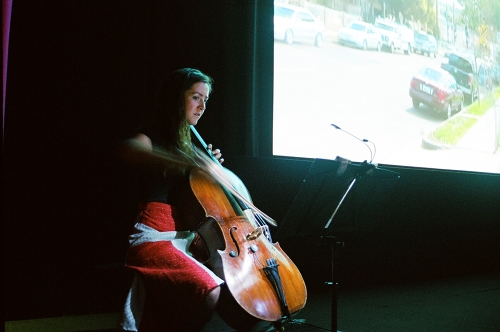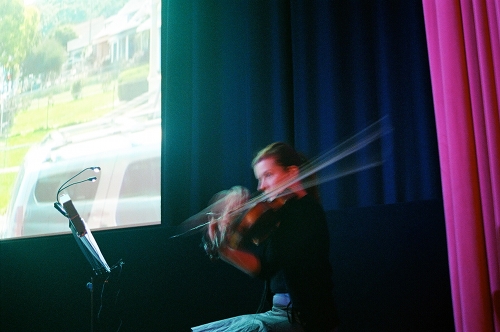Los Angeles intrigues. Myriad are the explorations thereof, from classic noir to reality shows, sci-fi to skid row, high-tech to lowriders. Much like the universe itself, the place feels infinite and ever-expanding. Thus is my interest piqued when artists seek to define -- or summon a definition of -- it. Goodness knows the highly imaginative "definitions" I've concocted from within innumerable cruel, frozen seas of eternal taillights! So mind, it's not generally an easy place but an immensely diverse and challenging one, inviting endless opportunities for interpretation.
This Tuesday night, May 1, at the REDCAT Theatre in downtown L.A.'s big shiny Disney Hall, four artists present their cross-disciplinary collaboration, Transparent Cities. Alternating between two vantages (Valencia and Highland Park), the work forms a study of the city via overlapping visual and aural field recordings, featuring both recorded and live music. Alphabetically, the artists are Madison Brookshire (video), April Guthrie (cello), Michael Pisaro (sound), and Cassia Streb (viola). These are interesting people, so I spoke with two of them.
April Guthrie is a musician of increasing renown, a cellist from age 9, holding a Master's in multi-focus performance from CalArts, and touring with acts ranging from Guthrie & Streb (with violist Cassia Streb) to Spiritualized to the worldly stylings of Moira Smiley & VOCO (with whom she first wowed me). A major proponent of performing the work of contemporary composers (including Wendy Melvoin and Lisa Coleman, a.k.a. Wendy & Lisa, which wows me again), Ms. Guthrie reveals that performing with Ms. Streb in the Silver ensemble of trumpeter-professor Wadada Leo Smith led to a connection with L.A.'s Hammer Museum, where Transparent Cities first took form. "Support the people around us," she enthuses, "and create a community while doing so.
"They said, 'We like what you [Guthrie & Streb] do, and what you stand for, and would love for you to create a show here,'" she adds, referring to the curators of the Hammer (including a grant from the Nimoy Foundation... small world!). "Their goal was to allow the artists to be as free as possible in their creation... which is really exciting!" Ms. Guthrie, who is classically trained but also likes to cut loose, laughs, "To not have rules! At that point, we approached Madison. Because we had always wanted to work with a filmmaker."
Turning to Mr. Brookshire (who is in Chicago during the interview, busily installing Passage, a collaboration with Tashi Wada, at Gallery 400), the evolution continues: "Then April and Cassia asked if there was anybody I wanted to work with, and I said I had always wanted to work with Michael [Pisaro], who I had studied with at CalArts." (Strong nexus, that CalArts!) "We decided that it was going to be a true collaboration," he adds. "Decisions would be reached by consensus, but each person would tend to his or her own area of expertise."
Now what about L.A.? I ask Madison what he finds daunting about the city, and what he finds inspiring. For inspiration, he cites its ethnic diversity and the fact that its ever-evolving sprawl keeps rent cheap enough to be an artist, and then: "Daunting may not be the right word for it, but I wish I spoke Spanish. It's one of the things I told myself I would do if I stayed here. I have a little bit of Spanish, but I'm not fluent, and I know that means there's a large part of the city that's unavailable to me." We continue to speak on the topic of distance, and how cross-town travel is "a real commitment." This leads to an intriguing concept: "One of the things that does interest me about Los Angeles, and one of the things that makes it different from some other cities, is that we do tend to measure distance in terms of time."
Mr. Brookshire continues: "The only other thing that I know of where that is the case, is film: You say you have a thousand feet of film, and that actually means that you have 28 minutes worth of movie." He adds, "There's this way of thinking about a conflation of time and space that's very interesting for me." Excellent. While Transparent Cities is immediately, if gently, concerned with both place and space, the element of time becomes a malleable component for all its collaborators.
I pose a similar question to April, but in terms of how she perceives (and plays to) Southern California now, in contrast to her arrival in the region nearly nine years ago.
"I had always lived in the Midwest, and it was my first time on a coast, and my first time in an environment that had a seemingly endless summer," she explains. "What changed the most was my perception of time, and how time passes. Because before I knew it, I had been living here for six months, and I had no idea that it was January.
"As an artist, it's a beautiful place to be creating within, because it's a seemingly magical, nonexistent world that I had started living in."
Ms. Guthrie elaborates that she did not expect to like L.A. but found that her preconceptions (i.e., Hollywood, cars, noise.) were mostly informed by people who don't live here. And then she strikes up a cool urban portrait:
"It's really expanded my idea of space and sound, because there are so many places in the city where it can be this absolute din of a place, where there's so much happening that you can't really hear your thoughts... in a wonderful way, though. And then you can go to another place that's only 20 minutes from there" -- again, time as a measure of distance! -- "where it's clear and open, and seemingly silent... in a way that you can focus more on small sounds, and pick out sounds through the transparency of a silent neighborhood."

Ms. Guthrie's field recordings were created in Valencia (as with Highland Park, over the course of a day), and although you will encounter mild traffic, a bird noise or two, and some sine waves added by Mr. Pisaro, really it's not until nearly the one-hour mark, when a police car or paramedic van screams past at a rather comfortable remove, that the urban contrasts may occur to the viewer/listener. (As a veteran film critic very accustomed to appraising elements like character and narrative and structure, I'm also tempted to add that this is the sort of peculiar production that might make Christopher Guest envious -- but allow me my baby steps as I waddle toward the art world.)
When asked about influences, Mr. Brookshire name-checks artists from German photographer Michael Wesely (known for taking, like, year-long exposures) to local-hero documentarian Thom Andersen (Los Angeles Plays Itself), and then divulges a bit of technique: "We wanted to try out different lengths of recordings. I think we tried out 3, 5, 7, and 11 minutes, something like that. We decided only to use prime numbers. So I had multiple recordings of the same camera positions, and when we were doing the tests I tried layering them. Everybody really liked that, so we decided to make that the basis of the piece.
"We realized that by making layers, you could learn something about the light. By combining different shots from different times of day, you got a composite color, just like Wesely's photographs. But since we're dealing with video, we also got a composite time. You could start to perceive patterns of movement and sound that happen over a day."
And Ms. Guthrie (in the midst of a discussion of music, gender, and the world that woefully does not fit here but may appear in my interview book) also reveals a bit of technique on the musical side. I ask if she and Ms. Streb will hold firm to specific motifs, or even a key.
"No. And Cassia actually did a wonderful thing during one half of her recordings, and had her viola tuned in a non-traditional tuning, so the notes weren't in any particular key. We trust that there might be moments of discord, which is so much more representative of how the world actually works... and not!" she laughs.
Transparent Cities begins Tuesday, May 1 at 8:30 p.m. (the time is unlikely to prove nebulous) and is preceded by Mr. Brookshire's new video/music composition, Five Lines. Click here to learn more.

